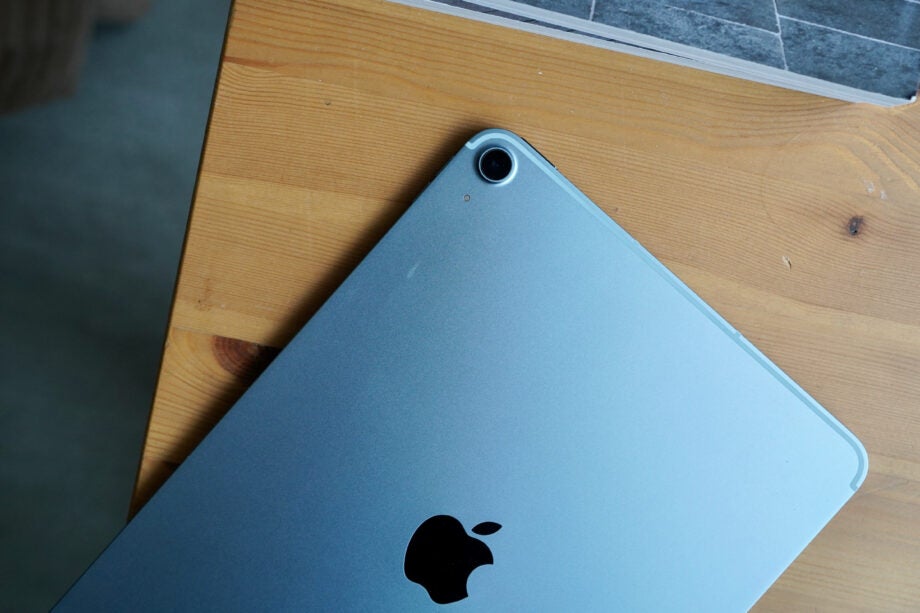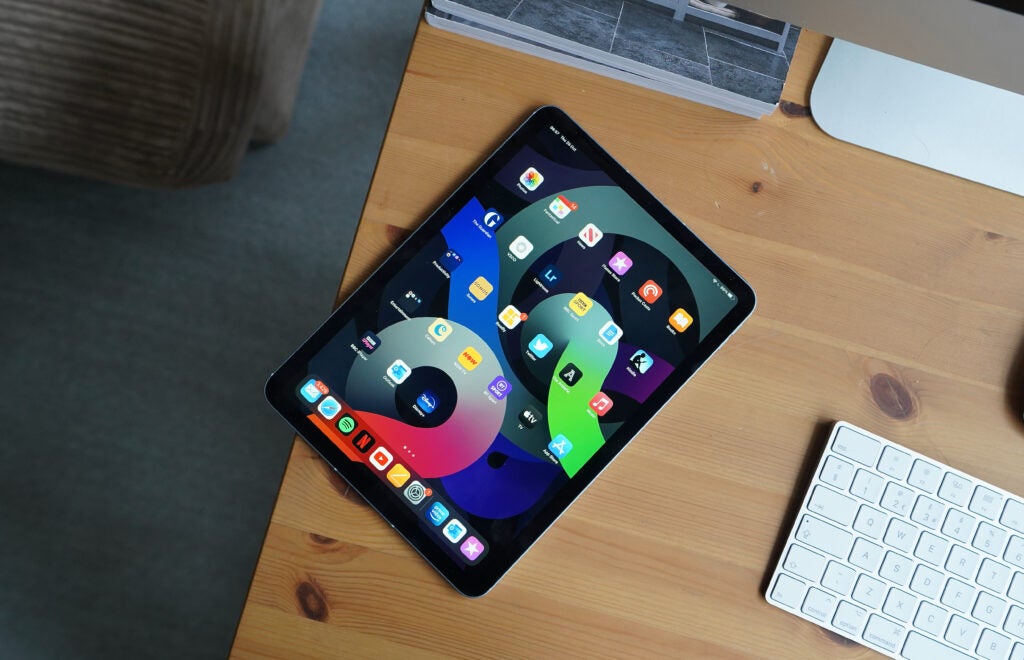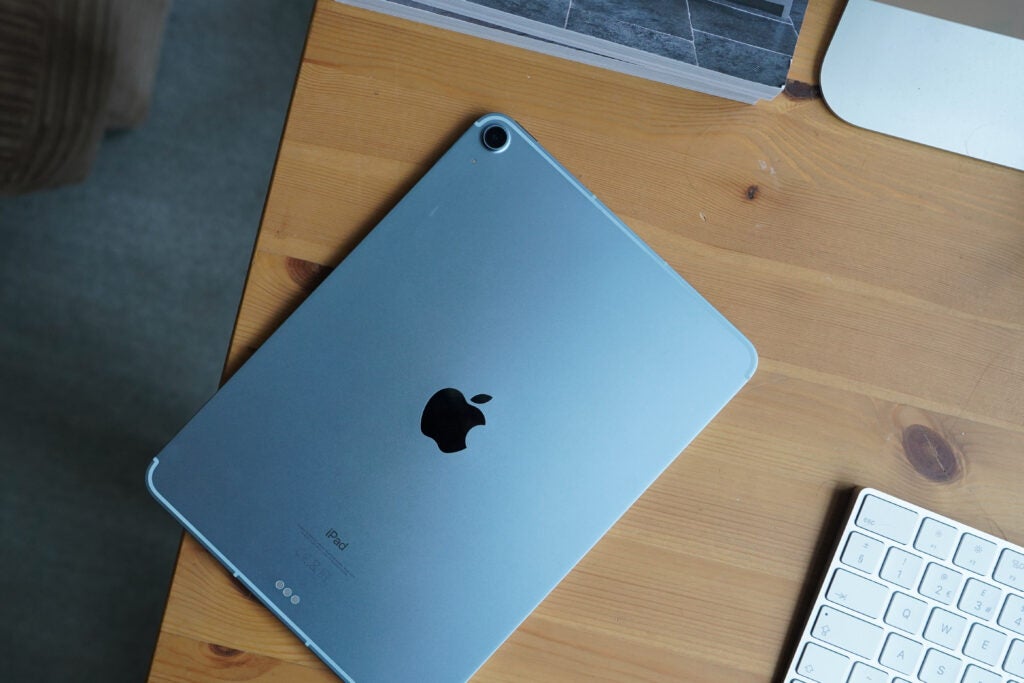iPad Air 4 Review
Huge upgrades


Verdict
The iPad Air 4 is a truly excellent tablet, especially for the £599/$599 price. It even makes the iPad Pro 11-inch a tough sell.
Pros
- Great new design
- Overall a huge leap for the Air line
- Better accessory support
- Very fast
Cons
- Odd gulf between storage options
- Apple Pencil and Keyboard cases are pricey
Key Specifications
- Review Price: £599
- 10.9-inch LCD display
- A14 Bionic chipset
- 64GB or 256GB storage options
- USB-C
The iPad Air 4 is a huge jump forward for Apple’s mid-range tablet, bringing down a number of previously Pro-exclusive features to a more affordable price.
There’s a whole raft of improvements over the outgoing iPad Air with this new 2020 model, many of which have been plucked directly from the iPad Pro (2020). This iPad Pro has now been updated, with the iPad Pro 2021 updating the processor to an M1 chip and a mini-LED screen.
You’ve got a new display, a sleeker design with a TouchID sensor embedded in the power button and a move to USB-C. There’s also an A14 Bionic chipset inside, just like the one you’ll find in the iPhone 12 range.
So, do all these improvements make for the easiest to recommend iPad currently on the market? Let’s dive in.
Design and screen
Finally, we have a completely new look for Apple’s mid-range tablet and I couldn’t be happier. After loving the squared-off, flat and boxy look of the iPad Pro (and now the new iPhone 12 line), it’s great to see it trickle down to the more affordable Air models.
Like the iPad Pro, the new Air has a bigger screen on the front that clings far closer to the edges and ditches the TouchID-enabled home button. The bezel around the 10.9-inch display is ever-so-slightly thicker than the Pro, however you’ll likely only notice this if you have both next to each other.
TouchID hasn’t been completely ditched though. Instead of sitting inside a home button, the biometric authentication method now lives in the slightly elongated (and very shiny) power button on the top. Going with a fingerprint instead of Face ID is likely a big cost-saver and I think I prefer it, especially when it’s as fast and reliable as it is here. It would have been great if this had made its way over to the iPhone 12, especially in a time where lots of people are wearing masks.
Setting up the Touch ID sensor is easy and will be familiar to anyone who has used a pre-Face ID iPhone or recent MacBook. You just rest and move your finger around the sensor and after a few seconds, it’s saved. I’d recommend adding in multiple fingers straight away as you likely won’t be using the iPad Air 4 in the same orientation all the time.
To unlock the iPad Air, just press the power button, rest your finger and keep it there for a second or so. This also works for other things, like authenticating payments and unlocking supported apps. I’ve found the sensor to be reliable and fast, though it does take a while to adjust if you’re coming from an iPad Pro with Face ID – though I would imagine that’ll be very few people.
Related: Best tablet
The iPad Air 4 is very similar to the iPhone 12 in terms of the design and Apple has stuck with the same aluminium body that wraps around the sides. It feels great to hold and leads to a light tablet that can be held for extended periods without issue. I’m a big fan of the colours here too, with the green and blue versions (you can see the Sky Blue variant in the accompanying pictures) looking great, if very subtle. In certain lighting conditions, you’d be forgiven for thinking the blue was grey.

Another big upgrade over the previous-gen Air is the new USB-C port on the bottom. This replaces the Lightning port and opens up a whole new ecosystem of accessories along with far quicker charging. You can connect USB-C dongles for file transfers for instance, or charge an iPhone. USB-C is used in a much wider range of devices than Lightning these days too, so if you have a recent MacBook Pro you’ll be able to use the same charger here.
The display is one of the few areas where the pricier iPad Pro model is clearly better as it has a faster 120Hz ProMotion screen. This gives everything a smooth sheen and makes games more responsive. With the iPad Air 4, you’ve got a more standard 60Hz display.
With that aside, this 10.9-inch screen is still great even if it lacks the punch of colour found on an OLED iPhone. It’s sharp thanks to the 2360 x 1640 resolution, has a decent anti-reflective coating and covers the wide P3 colour gamut. There’s True Tone too, which makes white backgrounds a little easier on the eyes.
Performance
Inside the iPad Air 4, you’ll find the same 5nm SoC (system on chip) Apple A14 Bionic that powers the iPhone 12 and iPhone 12 Pro. It’s one of the fastest chips around and will likely be the base of the upcoming Apple Silicon Macs. There’s also 4GB RAM.
I ran the Geekbench 5 synthetic benchmark test to gain a general idea of performance. The 1590 single-core and 4183 multi-core scores are comfortably above the outgoing iPad Air, however you’ll still get better graphics performance from the A12Z inside the iPad Pro.
The iPad Air 4 is supremely capable in pretty much every task. There’s not a game on the App Store that I have tried that’ll cause any issues, and even tasks like 4K video editing are handled with ease. The great selection of apps on the App Store, including LumaFusion for video editing and Lightroom for the photo retouching, also prove you’re not necessarily restricted by this not being a full computer.
On the back, there’s a 12-megapixel single camera without an ultra wide companion or even a flash. This is a good snapper though, and ideal for scanning a document or using AR software. Video calls are taken care of by the front 7-megapixel camera which is a lot better than the majority of laptops I have used. The biggest annoyance with video calls is that apps like Zoom still don’t work in multitasking, so you can’t be on a call and checking a document of notes at the same time. This is definitely something to consider if you’re planning on using this as your main work machine.
You’ve got great sounding speakers on either edge, though you will need to use an adaptor (not included) if you want to plug in a wired pair of headphones. Certain USB-C headphones work too, although I have found many pairs that don’t.
Oddly, Apple sells this iPad in only two storage options: 64GB and 256GB. I find the gulf between the two sizes strange and there’s hefty price hike if you, as I would, want more than 64GB. Offering a 128GB size, or in fact using that as the base, would make far more sense. If you want to spend even more, there’s a 4G option available too. For when you’re not on-the-go, there’s Wi-Fi 6 support too.

When it comes to software, the iPad Air 4 runs the latest version of iPadOS and should get upgrades for a number of years. iPadOS 14 wasn’t rammed with iPad-exclusive features, but I do really like the ability to use the Apple Pencil to write in text-boxes. For more on the software, check our iOS 14 features round up.
Accessories
Another previously Pro-exclusive feature inherited by this iPad Air is support for the newer, and far better, Apple accessories. These include the second-gen Apple Pencil, an updated folio keyboard and the excellent (if outrageously expensive) Magic Keyboard. These aren’t specific iPad Air versions either, but rather the same ones that are compatible with the iPad Pro 11-inch.
- Read more about the Apple Pencil in our iPad Pro 2020 review
I’ve been using both the Magic Keyboard and the Apple Pencil alongside the iPad Air 4 and they both add extra functionality to the device. The Pencil is responsive and an absolute pleasure to draw with. The extra speed of the iPad Pro screen does make for a better drawing experience there, but the difference is small. To charge and connect the Pencil just attach it to the magnetic portion on the side and it’ll attach.
The Magic Keyboard offers a robust typing experience, along with a responsive trackpad and sturdy stand. For a deeper look at this £299 add-on, read our Magic Keyboard review.
Battery life
As I mentioned above, Apple has switched from Lightning to USB-C with the new iPad Air 4 and this enables much faster charging than you’d get with older Airs. There is a 20w plug along with a USB-C to USB-C cable in the box and you’ll get a full charge in under two hours.
Battery life is pretty much what you’d expect from an iPad and Apple hasn’t really pushed endurance forward too much. It’ll get you through the day comfortably if you’re using it as a laptop replacement, though you’ll notice much faster battery drain with the backlit Magic Keyboard attached.
Apple’s claim of 10 hours of video playback rings true in my tests and you’ll get even longer if you’re viewing offline content.
Related: Best iPhone
Should you buy it?
The iPad Air 4 is a truly excellent tablet, especially for the £599/$599 price. It even makes the iPad Pro 11-inch a tough sell, as the only real benefit is the faster display (among other smaller differences like the addition of LiDAR).
Thanks to the new design, excellent fingerprint sensor, great accessory support and USB-C, the iPad Air 4 is the best tablet you can buy right now.


